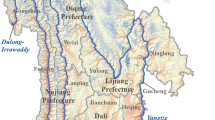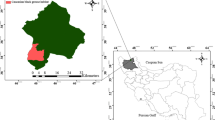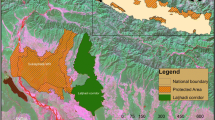Abstract
As wildlife habitat is in constant evolution, periodic monitoring is essential to assess its quality. In this study, the change to the red-crowned crane habitat in the Yellow River Delta Nature Reserve was detected from multi-temporal remote sensing data from 1992 to 2008 in a geographic information system. Habitat fragmentation was derived from both physical constraints and human disturbance. The changing habitat quality was assessed against five landscape indices. The results obtained from Landsat TM images indicate that potential habitat shrank 37.9 % during 1992–2001, but recovered 99.4 % by 2008. Suitable habitat shrank by 4,329 ha to a level below that of 1992 despite an increase of 4,747 ha in potential habitat due to an increase of 9,075 ha in fragmented areas. Both landscape indices and the red-crowned crane population reveal that suitable habitat was the most fragmented in 2001, but the least fragmented in 1992. Therefore, it is inadequate to just restore wetland through artificial diversion of channel flow to the Reserve to preserve the crane habitat. Commensurate efforts should also be directed at improving habitat quality by minimizing human activities and spatially juxtaposing water and reed marshes harmoniously inside the Reserve.






Similar content being viewed by others
References
Bi XL, Wang B, Lu QS (2011) Fragmentation effects of oil wells and roads on the Yellow River Delta, North China. Ocean Coast Manage 54(3):256–264. doi:10.1016/j.ocecoaman.2010.12.005
Cao MC, Liu GH (2008) Habitat suitability change of red-crowned crane in Yellow River Delta Nature Reserve. J Forestry Res 19(2):141–147. doi:10.1007/s11676-008-0024-5
Carmen R (2005) Developing indicators of ecosystem condition using geographic information systems and remote sensing. Reg Environ Change 5:205–214. doi:10.1007/s10113-004-0085-8
Cui BS, Yang QC, Yang ZF, Zhang KJ (2009) Evaluating the ecological performance of wetland restoration in the Yellow River Delta, China. Ecol Eng 35:1090–1103. doi:10.1016/j.ecoleng.2009.03.022
Day JW, Shaffer GP, Britsch LD, Reed DJ, Hawes SR, Cahoon D (2000) Pattern and process of land loss in the Mississippi delta: a spatial and temporal analysis of wetland habitat change. Estuaries 23(4):425–438. doi:10.2307/1353136
Fan H, Huang HJ (2008) Response of coastal marine eco-environment to river fluxes into the sea: a case study of the Huanghe (Yellow) River mouth and adjacent waters. Mar Environ Res 65(5):378–387. doi:10.1016/j.marenvres.2008.01.003
Gottschalk TK, Huettmann F, Ehlers M (2005) Thirty years of analyzing and modeling avian habitat relationships using satellite imagery data: a review. Int J Remote Sens 26(12):2631–2656. doi:10.1080/01431160512331338041
Harris J (1997) A future for China’s cranes. ICF Bugle 23(3):1–3
Hiroyoshi H, Yuri S, Jason M, Kiyoaki O, Sergey S, Go F, Kunikazu M, Yuria M, Mutsuyuki U, Vladimir A, Nagahisa M, Yutaka K (1998) Satellite tracking of the migration of the red-crowned crane Grus japonensis. Ecol Res 13(3):273–282. doi:10.1046/j.1440-1703.1998.00271.x
Hussain SA (1994) The present status of wetland conservation in Asia. In: Higuchi H, Minton J (eds) The future of cranes and wetlands. Wild Bird Society of Japan, Tokyo, pp 160–165
International Union for Conservation of Nature and Natural Resources (IUCN) (2007) IUCN Red List of Threatened Species
Joppa LN, Loarie SR, Pimm SL (2008) On the protection of “protected areas”. PNAS 105(18):6673–6678. doi:10.1073/pnas.0802471105
Ke CQ, Zhang D, Wang FQ, Chen SX, Schmullius C, Boerner WM, Wang H (2011) Analyzing coastal wetland change in the Yancheng National Nature Reserve, China. Reg Environ Change 11(1):161–173. doi:10.1007/s10113-010-0130-8
Li SN, Wang GX, Deng W, Hu YM, Hu WW (2009) Influence of hydrology process on wetland landscape pattern: a case study in the Yellow River Delta. Ecol Eng 35(12):1719–1726. doi:10.1016/j.ecoleng.2009.07.009
Li DL, Chen SH, Guan L, Lloyd H, Liu YL, Lv JZ, Zhang ZW (2011) Patterns of waterbird community composition across a natural and restored wetland landscape mosaic, Yellow River Delta, China. Estuar Coast Shelf S 91(2):325–332. doi:10.1016/j.ecss.2010.10.028
Liu GH, Drost HJ (1997) Atlas of the Yellow River delta. The Publishing Housing of Surveying and Mapping, Beijing
Liu JG, Linderman M, Ouyang ZY, An L, Yang J, Zhang H (2001) Ecological degradation in protected areas: the case of Wolong Nature Reserve for Giant Pandas. Science 292(5514):98–101. doi:10.1126/science.1058104
Lord JM, Norton DA (1990) Scale and the special concept of fragmentation. Conserv Biol 4(2):197–802. doi:10.1111/j.1523-1739.1990.tb00109.x
Ma ZJ, Li WJ, Wang ZJ, Tang HX (1998) The habitat change and adaption of red-crowned crane in Yancheng Natural Reserve. Ambio 6:461–464 (in Chinese)
Ma ZJ, Wang ZJ, Tang HG (1999) Habitat use and selection by Red-Crowned Crane Grus japonensis in winter in Yancheng Biosphere Reserve, China. Ibis 141(1):135–139. doi:10.1111/j.1474-919X.1999.tb04272.x
McGarigal K, Marks B (1995) FRAGSTATS: spatial pattern analysis program for quantifying landscape structure. US Forest Service General Technical Report PNW–GTR–351
Meine CD, George WA (1996) The cranes: status survey and conservation action plan. IUCN, Gland, Switzerland, and Cambridge, UK Northern Prairie Wildlife Research Center Online. http://www.npwrc.usgs.gov/resource/birds/cranes/index.htm (Version 02MAR98)
Noss RF (1996) Their role in environmental protection. In: Wright RC (ed) National parks and protected areas. Blackwell Science, Cambridge, pp 91–120
Ozesmi SL, Bauer ME (2002) Satellite remote sensing of wetlands. Wetlands Ecol Manag 10(5):381–402. doi:10.1023/A:1020908432489
Qin XW, Zhang SQ, Li XF, Na XD, Pan X, Yu H (2009) Assessment of Red-crowned Crane’s habitat suitability based on weights-of-evidence. Acta Ecol Sinica 29(3):1074–1082 (in Chinese)
Seto KC, Fragkias M (2005) Quantifying spatiotemporal patterns of urban land–use change in four cities of China with time series landscape metrics. Landscape Ecol 20(7):871–888. doi:10.1007/s10980-005-5238-8
Shu Y, Hu YM, Leng WF, Zhu YS, Shan K (2006) Habitat selection of red-crowned crane in Yellow River Delta. Chinese J Ecol 25(8):954–958 (in Chinese)
Wan DM, Gao W, Wang QY, Wang HT, Liu MY (2002) Effects of habitat fragmentation on nesting site selection of red-crowned crane. Chinese J Appl Ecol 13(5):581–584 (in Chinese)
Wang S, Hassan M, Xie X (2006) Relationship between suspended sediment load, channel geometry and land area increment in the Yellow River Delta. Catena 65(3):302–314. doi:10.1016/j.catena.2006.01.003
Xiao DN, Hu YM, Li XZ (2001) Landscape ecology research at wetland surrounding Bohai sea delta. Science Press, Beijing
Xu XG, Guo HH, Chen XL, Lin HP, Du QL (2002) A multi–scale study on land use and land cover quality change: the case of the Yellow River Delta in China. GeoJournal 56(3):177–183. doi:10.1023/A:1025175409094
Zhang YH, Deng W, Zhang SW (2006) The spatial structure analysis of the red-crown crane’s habitat in Xianghai National Nature Reserve based on RS and GIS techniques. Acta Ecologica Sinica 26(11):3725–3731 (in Chinese)
Zhao YM, Song CS (1995) Scientific survey of the Yellow River Delta Nature Reserve. China Forestry Press, Beijing
Acknowledgments
The research was supported by the National Science Foundation of China (40871230) and the Special Project of Water Body Contamination Control and Treatment of China (2008ZX07526-007).
Author information
Authors and Affiliations
Corresponding author
Rights and permissions
About this article
Cite this article
Wang, H., Gao, J., Ren, LL. et al. Assessment of the red-crowned crane habitat in the Yellow River Delta Nature Reserve, East China. Reg Environ Change 13, 115–123 (2013). https://doi.org/10.1007/s10113-012-0325-2
Received:
Accepted:
Published:
Issue Date:
DOI: https://doi.org/10.1007/s10113-012-0325-2




